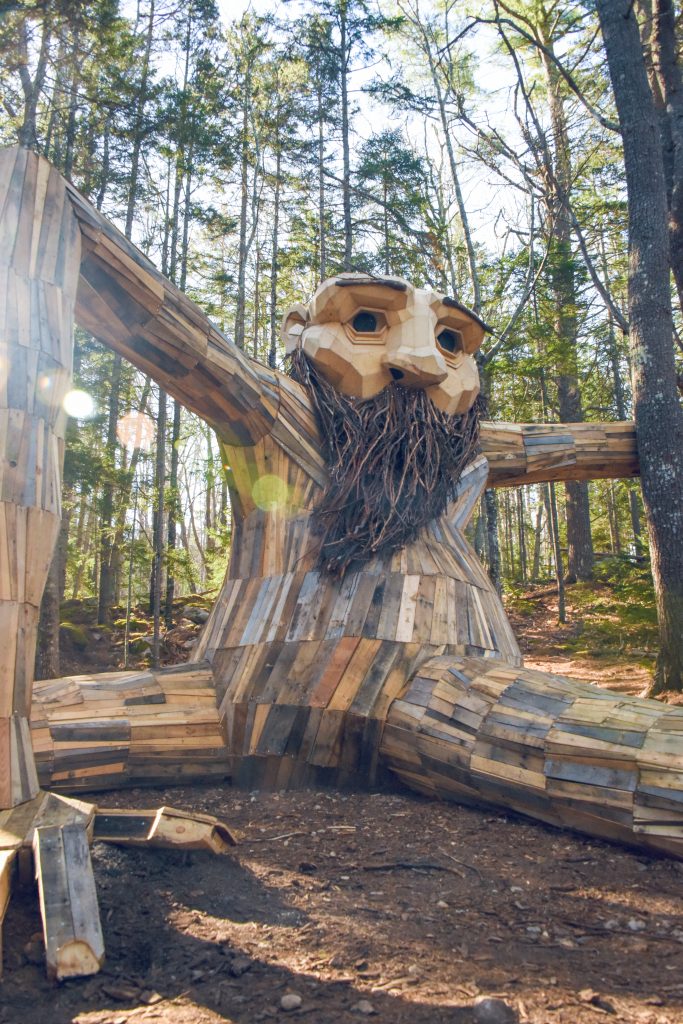Planning a Troll Hunt?
Be prepared for your visit
Know Before You Go
Exploring Guardians of the Seeds by Thomas Dambo is an exciting, new part of the Gardens experience and is included with regular Gardens admission—make sure you get your ticket in advance. Our Trolls Map & Guide is available at the front desk when you arrive, and will help you on your search.
This experience is a hike in the woods – please come prepared with sturdy, comfortable shoes, bug spray, sunblock, and water. For young children, we recommend hiking strollers or child carriers—standard strollers may not be able to handle all terrain. The five trolls are hidden deep in the woods, and you should not necessarily expect to see them all in one visit; some of the trolls require a lot of walking, so plan your visit accordingly.
Time estimates to see the trolls:
- 1-2 trolls = 45 minutes
- 3 trolls = 90 minutes
- 5 trolls = 2.5-3 hours
- 5 trolls + seeds = 4-5 hours
FAQ
No, general admission covers the entire experience. While special tickets are not needed for this experience, admission tickets to the Gardens must be purchased in advance.
The five trolls are hidden deep in the woods, and you should not necessarily expect to see them all in one visit; some of the trolls require a lot of walking. While our first troll is in the central gardens, the others are in the woods, about a half-mile apart from each other. The Guardians of the Seeds Map & Guide, available at the front desk, will guide you to each troll. To see all five trolls, the hike will be about three miles. Some paths are steep and unimproved. To see the seeds too, the hike will be an additional two miles, round-trip.
Consider a Gardens membership, which is valid for a year after purchase and pays for itself in two visits. If purchased during your visit, you can apply the cost of your admission ticket to the price of a membership.
The seeds are in our woods, kept safe by the trolls. Visit each troll by following the instructions in the Map & Guide, and the signs at each troll will give you the clue needed to solve the puzzle and find the hidden seeds.
Feel free to hug and/or take pictures with the trolls, but we ask that guests refrain from climbing so that we can enjoy them for many years to come.
The trolls and secret seeds are spread throughout our woods, and some trails are steep and unimproved. The two trolls located closer to our central garden area may be easier to get to, and the first troll is accessible to all visitors. Our Map & Guide can give you more information.
The trolls are a walking/hiking experience spread throughout our wooded areas and trails. Our shuttle route runs close to some trolls, but has very limited capacity. We discourage visitors from trying to use the shuttle to experience the trolls.
As long as the trolls will stay! We plan to take great care of our troll friends and hope to have them here for many, many years. With that said, they are made from natural, recycled materials and live out in the elements, subject to all the natural wear and tear that comes along with anything that lives outside in Maine year-round.
Thomas Dambo, a Danish artist and recycle activist. He led a team of community and worldwide volunteers to help create our five trolls. They are part of a larger family of trolls all over the world, including China, Australia, Belgium, Puerto Rico, Mexico, and South Korea. You can learn how our trolls are connected to Dambo’s global fairytale at trollmap.com.
Thomas and his crew made the heads, feet, and hands in their studio in Denmark. Once fumigated for pests, they were brought over in a shipping container. Once on-site, the bodies and heads were put together by his crew of 10 people from all over the world as well as over 150 local volunteers and staff. They took about two months to make.
The trolls are primarily constructed from recycled pallets and other recycled wood. Each face is a different story of salvaged wood – for example, Lilja’s consists of salvaged floorboards, and Roskva’s was salvaged from a Danish transfer station.
Additionally, many parts come from materials collected on-site. Birk’s hair was made from roots of downed trees from our property, and Roskva’s and Gro’s fur is oak bark, a milling byproduct of fallen logs salvaged for lumber. Organizations providing salvaged materials include Molnlycke, Louis Doe Home Center, Yoder Sawyering, Viking Lumber, and Brooks Feed and Farm.
